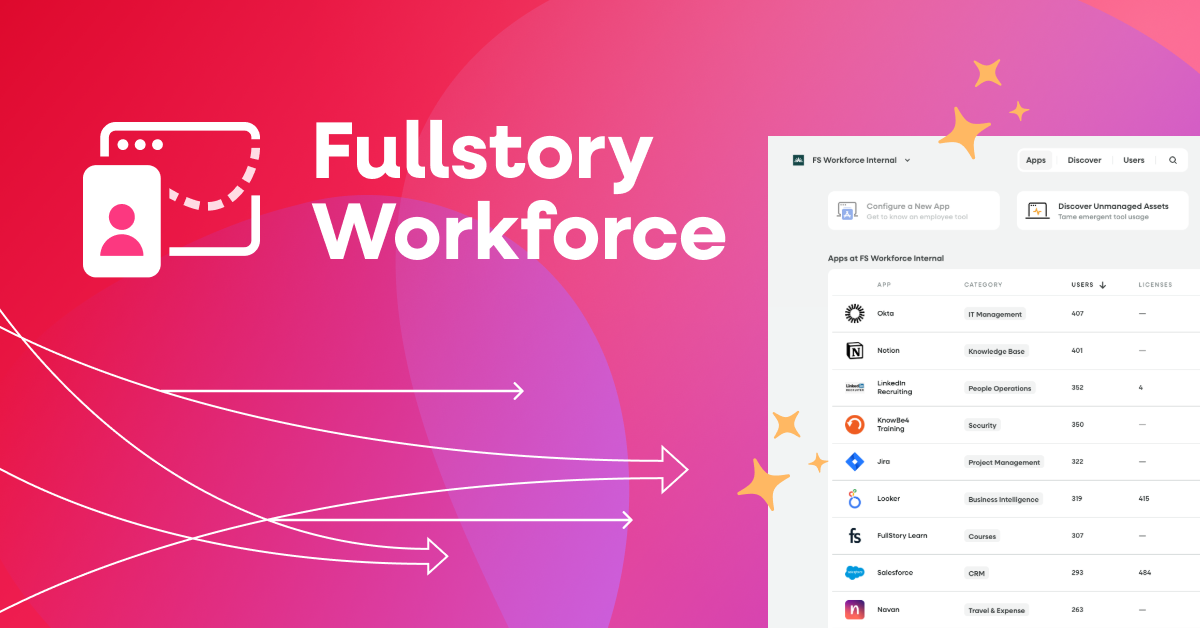Clunky digital tools cost brands millions in lost productivity, security risks, and turnover. But without visibility into how (or if) employees use these tools, they can't identify friction points, optimize workflows, or prevent costly workarounds.
We sat down with three experts from the team behind Fullstory Workforce to explore how brands can better understand, measure, and improve how employees interact with their tools.
The growing importance of the digital employee experience
As AI raises the bar for productivity, employees are feeling more pressure than ever to work more efficiently. If the tools they're given are slow, confusing, or disconnected, it makes it hard for them to do their jobs effectively. And when employees turn to unauthorized tools to improve productivity or fill gaps, it creates security risks for the entire organization.
What is swivel chair behavior, and how does it negatively impact organizations?
Swivel chair behavior refers to employees constantly switching between applications to complete a single task, like copying contact details from one system to paste into Salesforce, then switching to another app to document meeting notes. This back-and-forth wastes time, and the context-switching creates mental fatigue that makes it hard for employees to stay focused and productive.
What is Workforce, and why does it exist?
Workforce captures behavioral data that shows how people interact with different applications and systems throughout their workday. Unlike traditional monitoring tools that track basic metrics like logins or require heavy installation, Workforce reveals the real patterns of how employees work—think: inefficiencies, workarounds, and gaps between intended and actual tool usage.
What problems does Workforce solve that other solutions don’t?
Organizations often rely on surveys and feedback to understand how employees use their digital tools, but this only reveals what people say, not what they do. And while some monitoring tools can track whether individual systems are being logged into, they miss how employees move between multiple applications to get work done. Workforce captures the complete picture of how people work, which tools they rely on, where friction occurs, and uncovers opportunities for optimizing employee workflows and saving money.
How does Workforce prioritize employee privacy?
Workforce observes how employees use digital tools, but with built-in privacy safeguards. Companies must actively choose which applications to monitor and configure specific privacy settings for each domain. Nothing is automatically tracked; every data collection decision requires conscious configuration and clear privacy boundaries.
What data does Workforce capture, and what stays private?
Workforce starts by providing anonymized, high-level data about which tools employees use. Brands then choose which applications to monitor more closely, with options ranging from full capture to private-by-default mode. The platform includes built-in tools to mask sensitive information while still tracking interactions or to completely exclude certain elements from capture. Brands can also enable optional employee opt-in for data collection.
What problems are companies using Workforce to solve?
Companies across industries are using Workforce as a form of productivity analytics, uncovering hidden issues in digital workflows�—problems that hurt efficiency, cause frustration, and cost time and money.
One enterprise discovered their team was constantly switching between CRM, dispatch, and mapping software due to outdated integrations—a fix that took minutes but saved hours. Another found hundreds of employees struggling with an ambiguous CRM button, causing constant rework. An airline used Workforce to identify complex processes that happen only twice yearly, where different employees waste full workdays relearning the same steps.
Organizations also use Workforce's detailed workflow data to guide their AI initiatives, ensuring automation efforts target actual employee behavior rather than assumed processes.
→ Want to learn more? Read how one Fortune 10 company optimizes Salesforce using Workforce.
Why we built Workforce as a browser extension
Workforce uses Fullstory's Fullcapture technology in a browser extension, eliminating the need for manual instrumentation across devices and employees. This approach allows monitoring of any web-based application—including third-party software where companies don't have source code access—without requiring heavy engineering work. Companies can deploy the extension in three ways:
Through managed browser policies (like Microsoft Edge Enterprise or Google Workspace)
Via endpoint management tools for unmanaged browsers
Through email invitations for smaller deployments or unmanaged devices.
Unlike traditional tools that require invasive desktop or application-level installation, Workforce's browser extension approach avoids performance risks and implementation complexity.
Build a better digital employee experience
Digital tools shape how effectively employees can do their jobs. A poor digital employee experience leads to frustration, lost productivity, and security risks when employees use unauthorized solutions.
Brands can begin improving by interviewing teams about their tool frustrations, analyzing help desk tickets for patterns, and observing workflows firsthand. While these manual approaches help, they only reveal part of the picture—you need behavioral data to understand and improve the digital employee experience.
Ready to see how Workforce can help? Watch a demo to learn how behavioral data reveals workflow inefficiencies, unused licenses, and opportunities for automation that could save your company millions.




